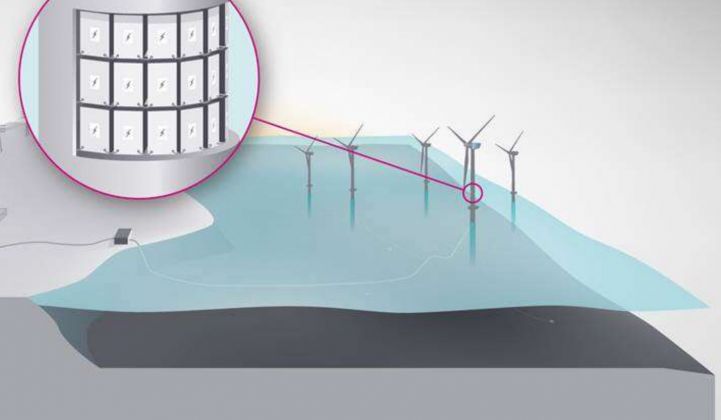The Norwegian state-owned oil company Statoil is planning to add a 1-megawatt-hour lithium-ion battery system to a floating offshore wind farm in late 2018.
The project, called Batwind, is being developed to capture excess wind power, reduce balancing costs and increase revenues through price arbitrage, according to a Statoil presentation.
It will be located alongside what Statoil claims is the world’s first floating wind farm -- the five-turbine, 30-megawatt Hywind plant 25 kilometers off the coast of Peterhead, in Aberdeenshire, Scotland. The project is due to start delivering power to the grid next year.
The Batwind battery array will be installed on the coast, where the wind farm’s export cable comes to shore, although Statoil will also be investigating the potential for offshore storage with batteries integrated into turbine towers.
“With Batwind, we can optimize the energy system from wind park to grid,” said Stephen Bull, Statoil’s senior vice president for offshore wind, in a press release. “Battery storage represents a new application in our offshore wind portfolio, contributing to realizing our ambition of profitable growth in this area.”
In an interview, Statoil spokesperson Elin Isaksen said costs for Batwind could not be disclosed “due to current negotiations with the potential suppliers."
“We can say it is a small project, but it has important implications for us," said Isaksen.
The oil firm is expecting to select a battery vendor in early 2018 and install the system later that year. “The pilot is testing both the technical solution and the commercial application of the battery connected to the wind farm," said Isaksen.
Statoil is not planning a time limit on the pilot, “other than what makes sense from a cost-versus-value perspective,” said Isaksen.
Ultimately, however, Statoil hopes to develop Batwind into a commercially viable proposition for wind energy storage.
“The success criteria [for the project] will be when, if, we get sufficient data and learning to implement this, or a different solution based on the data and experience, in a full-scale commercial setting and have an acceptable return on investment,” Isaksen said.
“We believe this is part of a skill set we must have for future developments. We will capture the knowledge from this pilot on Hywind Scotland for future full-scale wind farm developments.”
Batwind is believed to be the first example of energy storage tied to floating turbines, and one of only a handful of battery projects related to offshore wind.
In December 2015, U.S. developer Deepwater Wind proposed linking two onshore lithium-ion battery arrays, totaling 15 megawatts of capacity, to its fifteen-turbine, 90-megawatt Deepwater ONE-South Fork project.
The storage, to be provided by GE, could be installed by 2018 ahead of construction for the offshore wind farm, which is expected to start in 2019 and finish in 2022.
“The energy storage facilities will be located on industrially zoned sites on Industrial Road in Montauk and at the Wainscott Commercial Center,” said Deepwater Wind in a press statement.
Onshore, GE’s Brilliant wind turbine range has featured built-in battery storage since 2013. But the energy storage technology most commonly associated with onshore wind is pumped hydro, because of its low capital cost per cycle.
Increases in onshore wind capacity are sparking renewed interest in pumped hydro across Spain, Germany, Italy, China, Japan and the U.S.
Hugh Sharman, principal at Danish energy consulting firm Incoteco, said the Batwind project signaled growing price-competitiveness for battery storage.
“As far as I am aware, Batwind appears to be a small component of a floating turbine development project, so it’s not even meant to be profitable,” he said. “[But] the global possibilities for non-battery storage are visibly shrinking as batteries get cheaper.”
Statoil believes the batteries could improve overall system cost. “Battery storage has the potential to mitigate intermittency and optimize output. This can improve efficiency and lower costs for offshore wind.”
U.K. policymakers apparently agree. According to a government report cited by Scotland’s Energy Minister Fergus Ewing, storage could lead to system-wide savings across the U.K. of up to £2.4 billion ($3.5 billion) a year by 2030.



